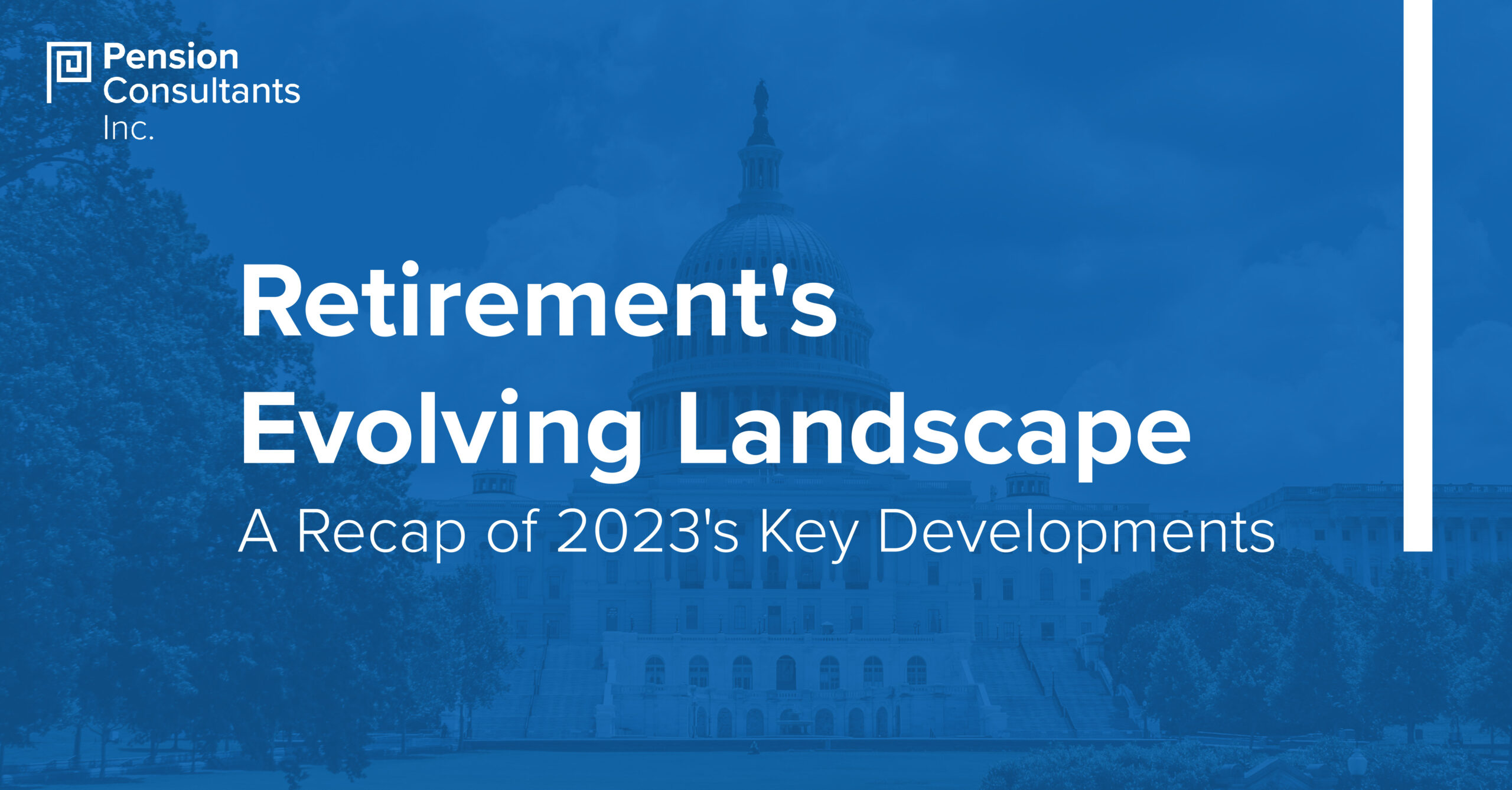Featured
Fiduciary Tools
News and Updates
Retirement’s Evolving Landscape: A Recap of 2023’s Key Developments
Last Updated: December 19, 2023

As we say goodbye to 2023 and hello to 2024, let’s take a moment to reflect on the news and trends that shaped the retirement planning industry in 2023. These are our top stories of the year.
SECURE 2.0
In 2023, the retirement world saw a significant shift with the arrival of the Secure 2.0 Act, a groundbreaking legislation that brought forth a host of new provisions relating to employer-sponsored retirement plans.
Signed into law on December 29, 2022, SECURE 2.0 addresses many of the issues that were not a part of the original SECURE Act, with the hopes of enhanced benefits to employees (and employers) and increased retirement savings opportunities. Secure 2.0 took effect immediately for certain provisions, with others implemented throughout 2023 and beyond. Fiduciaries are advised to remain informed about ongoing changes.
Unpacking Secure 2.0: A Title-by-Title Brief Review 1
● Title I – Expanding Coverage and Increasing Retirement Savings
Title I promotes accessible retirement by automatically enrolling employees, supporting small businesses with retirement plans, diversifying savings options, and simplifying job transfers.
● Title II – Preservation of Income
Title II broadens retirement income options. It opens avenues for a secure retirement by removing restrictions on life annuities in qualified plans and IRAs, providing flexibility for longevity annuity contracts, introducing a new insurance-focused ETF, and eliminating penalties for partial annuitization.
● Title III – Simplification and Clarification of Retirement Plan Rules
Title III introduces flexible overpayment recovery, reduces penalties for failure to take a minimum required distribution, and creates a retirement “lost and found,” among many other provisions.
● Title IV-VII – Summary of Other Provisions
–Title IV refines Secure 2.0 with eight technical and clerical amendments.
–Title V extends the plan amendment deadline.
–Title VI adjusts retirement plans, allowing Roth contributions, aligning rules, and extending benefits with varied effective dates.
-Lastly, Title VII ensures fair benefits for Tax Court judges, aligning them with federal judges.
While Secure 2.0 is a significant step forward, it’s important to note that it’s not perfect and still has some way to go. Proposed fixes include correcting errors related to catch-up contributions, aligning Starter-K plan limits with IRAs, and clarifying the age for starting required minimum distributions. Notably, Secure 2.0 does not address 403(b) plans’ access to collective investment trusts (CITs).2
As we move forward, it remains important to stay informed about these evolving regulations and adapt our retirement plan strategies that work in employee’s favor.
3 ½ Top Yet Uncommon Tips
to Level Up Your 401(k) Investment Lineup
As a fiduciary, you’ve got a lot on your plate. We understand the weight of those responsibilities. That’s why we put together PCI’s 3 ½ top, yet uncommon, tips to level up your plan’s investment lineup.
New Proposed Fiduciary Rule
In a move that could potentially impact financial advisers and their practices, the Department of Labor (DOL) has proposed a new fiduciary rule to better protect participants’ savings.
The proposed changes aim to ensure that retirement plan participants receive objective and high-quality guidance from their advisers, free from conflicts of interest.
The DOL’s proposal also seeks to create more consistent and protective conditions for exemptions from the fiduciary rule. This will ensure that all retirement investors receive the same level of protection, regardless of the specific products or services they choose.
The ultimate goal is to establish fair and balanced rules that benefit both investors and financial advisers.3 We firmly believe in the DOL’s proposed rule and its potential to enhance protections for participants.
The Ongoing Success of Auto Enrollment
The Society for Human Resource Management’s 2020 Employee Benefits report reveals significant trends in retirement benefits in the U.S.:
● 51% of HR professionals automatically enroll employees in a 401(k)-type plan, up from 39% in 2018.
● 26% automatically increase employee contributions annually, up from 18% in 2018.
● Vanguard Investments found that 90% of automatically enrolled new hires stayed in their employer’s plan after three years.
A Principal Financial Group poll in 2021 found that 84% of workers automatically enrolled in retirement plans started saving sooner. Positive effects for sponsors include higher employee savings (65%) and faster plan asset growth (47%). Automatic enrollment, along with company matching and financial education, proves effective in promoting retirement savings.4
PCI believes that auto features, such as auto-enrollment, are a powerful tool in improving participant retirement readiness. Prioritizing sufficient participant contributions is paramount, as having great investment returns and minimal plan fees alone cannot offset low contributions. Auto-enrollment serves as an effective means to help get participants on the track for retirement.
The Industry’s Persistent Push for Managed Accounts and Annuities
The industry continues its aggressive marketing of unnecessary ancillary products, such as 401(k) managed accounts and annuities. Be on the lookout for these products as they might not be as beneficial to your participants as sellers would like you to think. Service providers and insurance companies are incentivized to sell these products, despite their add-on fees and potential to erode participants’ retirement savings.
401(k) Participant Managed Accounts
Managed Accounts are not a new topic for us. We covered several red flags associated with Managed Accounts thoroughly in the following blogs:
401(k) Participant Managed Accounts have many concerning issues, such as lacking objective performance benchmarks and burdening participants with expensive fees that add up over time. Fiduciaries need to stay vigilant about offering Managed Account services to plan participants.
Annuities
Many investors see annuities as a viable retirement alternative. These financial agreements promise participants a stream of income or lump sum future payment in exchange for an investment with an insurance company.5
However, there are many risks associated with investing in annuities. Issues arise when dealing with shady sales tactics. It’s important to understand the risks associated with annuities before you pour your participants’ well-earned savings down the drain. Unscrupulous sellers often use high-pressure tactics, like cold calls, limited-time offers, and seminars, to sell annuities. Be wary of free meals, gifts, or agents with fake titles.
Reserve your spot for our upcoming workshop.
- Sources:
1) “SECURE 2.0 Act of 2022.” The United States Senate Committee on Finance, https://www.finance.senate.gov/imo/media/doc/Secure%202.0_Section%20by%20Section%20Summary%2012-19-22%20FINAL.pdf
2) Anderson, Brian. “3 Key Fixes in New SECURE 2.0 Technical Corrections Bill.” 401(K) Specialist, 401(k) Properties LLC., 8 Dec. 2023, 401kspecialistmag.com/3-key-fixes-in-new-secure-2-0-technical-corrections-bill/?utm_source=email&utm_medium=email&utm_id=1992626185&utm_content=600f4cec47bb037cc38bb9d1. Accessed 11 Dec. 2023.
3) “US Department of Labor Announces Proposed Rule to Protect Retirement Savers’ Interests by Updating Definition of Investment Advice Fiduciary.” Department of Labor, Employee Benefits Security Administration, 31 Oct. 2023, www.dol.gov/newsroom/releases/ebsa/ebsa20231031. Accessed 7 Dec. 2023.
4) CEBS, Stephen Miller. “401(K) Auto-Enrollment Proves Popular.” Society for Human Resource Management, Society for Human Resource Management, 7 Apr. 2022, www.shrm.org/resourcesandtools/hr-topics/benefits/pages/401k–auto-enrollment-proves-popular.aspx. Accessed 7 Dec. 2023.
5) “Annuities | Investor.gov.” U.S. Securities and Exchange Commission Office of Investor Education and Advocacy, U.S. Securities and Exchange Commission Office of Investor Education and Advocacy, www.investor.gov/introduction-investing/investing-basics/investment-products/insurance-products/annuities. Accessed 7 Dec. 2023.
Pension Consultants, Inc. is registered with the U.S. Securities and Exchange Commission as an investment adviser, located at 300 S. Campbell Ave., Springfield MO, 65806. For questions or more information contact us at 417.889.4918.




